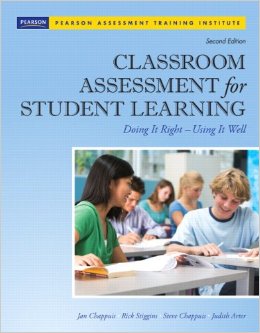Classroom Assessment Chapter 3

To help us work towards our school goal of improving our understanding and practice of assessment, my principal has provided our staff with a copy of Classroom Assessment for Student Learning: Doing it Right – Using it Well, by Jan Chappuis, Rick Stiggins, Steve Chappuis, and Judith Arter. As I make my way through the book, I will be summarizing my learning as a means of organizing my thoughts and getting clarification on particular ideas.
 |
| Classroom Assessment for Student Learning Cover. (Accessed 2016). Uploaded to Amazon; Pearson Education. Available online at: https://www.amazon.ca/Classroom-Assessment-Student-Learning-Doing/dp/0132685884 |
Chapter 3 – Clear Targets
*learning targets are statements of the intended learning
Knowledge Targets
– the factual, procedural, and conceptual understandings at the root of any subject
– factual and procedural
– know, list, name, identify, know how to, use
– low-level Bloom’s taxonomy
– conceptual
– understand, explain
– knowing via reference
– things students don’t need to memorize
– make sure students know how to find the right answers
Reasoning Targets
– the thought process to apply and transfer knowledge across subjects
– inductive and deductive inference
– a reasonable guess/conclusion based on info/clues
– inductive uses evidence to infer a rule/principle; “reading between the lines”
– deductive uses rules/facts to infer a conclusion
– analysis
– to examine the components/structure of something
– comparison
– sorting things into categories by characteristic
– evaluation
– expressing and defending an opinion, a point of view, a judgement or decision
– synthesis
– combining elements to make something new
*make sure you don’t accidentally turn a reasoning target into a knowledge target
– for example, if you compare/contrast characters verbally in class as you read a novel then this would be a
knowledge question if asked again on a test because students are simply recalling
Skill Targets
– when a demonstration of physical skill-based performance is central to the learning
– serving a volleyball, kneading dough, conversing in a second language
Product Targets
– when the creation of an artefact/product is the focus of the learning
– the qualities of that product are assessed
* don’t confuse and activity with assessment of the learning target; ask yourself “what should they be learning” NOT “how will they demonstrate it”
Disposition Targets
– a student’s attitude, motivations, and interests; a byproduct of education experiences
– value outcomes in social studies
– learning behaviours on provincial report cards
How to Deconstruct Curriculum Standards
1 ) Determine the target type (see above)
2 ) Identify the pre-requisite knowledge/skills needed
3 ) Check for accuracy and reasonableness
 |
| Chappius, et al. (2012). Figure 3.11 Benefits of Clear Targets. Classroom Assessment for Student Learning, pg 74. |
_____________________________________________
I WANT TO KNOW:
Do you clearly state the target of the lesson for your students every class?
This chapter shared a teacher story where she admitted that she used to assume that the purpose of the day’s lesson was clear and evident based on her discussions; when students where prompted, however, they were unclear.
I am guilty of assuming the purpose of the lesson is clear. I discuss learning targets with students but probably not as often as a should; I don’t do it every class.
Please leave your thoughts below 🙂